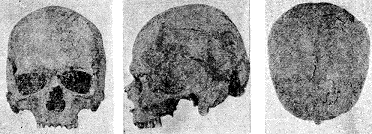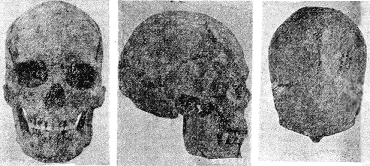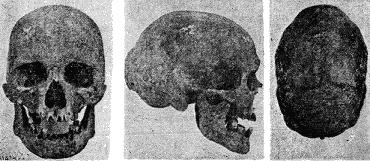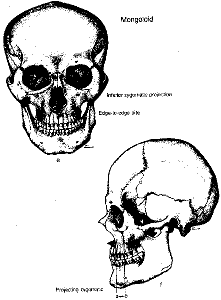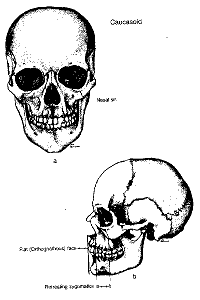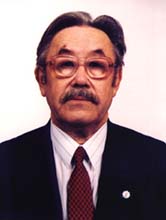 |
O.Ismagulov |
||||||||||||||||||||||||
|
|||||||||||||||||||||||||
|
Foreword |
|||||||||||||||||||||||||
|
For Foreword and Mini-Glossary cliuck on
Table of Contents Page numbers are shown at the end of a page. Translator' comments and clarifications are shown in blue, and Translator-added chapter sub headers are shown in bold blue. Translator's notations identifying locations on the map are shown in square brackets in bold blue: [11]. |
|||||||||||||||||||||||||
Chapter 1 |
|||||||||||||||||||||||||
|
7 start Andronov Culture In the Bronze Epoch, in Kazakhstan are typical monuments of the so-called
Andronov Culture. They remain as settlements, burials and mines. The main occupations of Andronovans
were cattle breeding and hoe agriculture. They were settling on the
banks of the rivers and lakes, in places with soil suitable for agriculture.
Tens of settlements of that culture were found in Kazakhstan. Among them most interesting are
settlements near a village Alekseyevka on r. Tobol (Krivtsova-Grakova, 1947), Bugulin and
Karkaralin in the Central Kazakhstan (Margulan et al., 1966). There
were found richest production and household objects. Entombments of
that time are represented by cemeteries consisting of one or several tens
of the tombs surrounded with round or rectangular fencing of stone. Diseased were laid on the left side
in fetal position, head to the west or southwest. Also were
encountered paired burials with diseased laid face to face in fetal
position. In the tombs were one or several ritual pots, and quite often nearby were found copper beads or
a bronze knife. The Andronovans pottery is covered with complex ornament
of triangles, rhombuses, meanders and other geometrical shapes. The whole material complex testifies about a
high economical and cultural level of the Bronze Age Andronovan tribes
in Kazakhstan. However, the materials of that period remained
chronologically undifferentiated for a long time. Only in 1948 K.V.Salnikov, after a careful analysis of ceramic products and burial rituals in the area east of Urals (Salnikov, 1948), auspiciously classified monuments of the Bronze Age. In his monograph about the ancient history of Southern Ural, K.V.Salnikov (1967) divided the Andronov Culture into three sequentially superseding each other stages: Fedor (18 - 16 centuries BC), Alakul (15 - 12 centuries BC) and Zamaraev (12 - 8 centuries BC). Later K.A.Akishev divided Central Kazakhstan monuments of Andronov Culture into the same periods (1953), but replaced Zamaraev stage with Dandybai. Later A.M.Orazbaev (1958) extended Salnikov's East Uralian classification to the northern monuments of Kazakhstan. He differentiated Zamaraev stage into an independent culture in Northern Kazakhstan. À. X. Margulan and K.A.Akishev suggested somewhat different periodization of the Bronze Age in Central Kazakhstan. In that territory they isolated two Bronze Epoch independent archeological cultures, Andronov and Begazy-Dandybai. In turn, they divided Andronov into two stages: Early Andronov, called Nurin, and Late Andronov called Atasu. In the opinion of the authors, Nurin and Atasu stages are synchronous, and in culture are generally close to Fedorov and Alakul stages in the area east of Urals, and the Begazy-Dandybai Culture is close to Karasuk to culture of the Minusinsk depression (Margulan, Akishev, etc., 1966). S.S.Tchernikov (1960) in his monograph gives divisional partitioning of the Andronov Culture in East Kazakhstan. From the developmental features of Irtysh tribes, he subdivided the Bronze Epoch period into four chronological stages: 1) Ust-bukon (18 - 16 centuries BC), 2) Kanai (16 - 12 centuries BC), 3) Small Krasnoyarsk (12 - 10 centuries BC) and 4) Trushnikov (10 - 7 centuries BC). Thus, all monuments of that time differ not only by chronological periods, but also by ethnographic features, depending on the territories of their occupation. It should be noted that periodization
of the Kazakhstan Bronze Epoch is not finalized, and the opinions about it diverge till now
(as of 1970 - Translator's Note). There is also no uniform point of view in
the definition of both initial and final dates of the Andronov Culture. But
the general framework of the Andronov Culture is established within the
limits of the 17 - 8 centuries BC. For understanding of the features
in the historical development of the tribes during Bronze Epoch in Kazakhstan not less important is
the study of the origin problem for the Andronov Culture. Most of its monuments are located in
the territory of Kazakhstan, they are also widely known beyond its limits. Now it is clear that the Andronov Culture area covers territory from Urals in the west to Enisei in the east, and from the Kurgan and Novosibirsk cities in the north to Fergana valley and Tien Shan in the south. Such huge area of Andronov settlement could not fail to cause interest among researchers to the genesis of these monuments. The question of Andronov Culture genesis was discussed repeatedly, but till now remains unresolved. We are interested only in the most important conclusions about that problem, which could have been used for the anthropological analysis of the Kazakhstan population at that period. Andronov Culture origins In respect to the origins of the Andronov Culture some researchers resorted to only pointing out that the Minusinsk depression was an east periphery of that culture (Teplouhov, 1929), while others suggested that it developed on the base of the Afanasiev Cultures of the Minusinsk depression (Kiselyov, 1951). Later, S.V.Kiselyov (1957) leaned to the western origin of the Andronov Culture. Another opinion on that problem held A.A.Formozov. He viewed the Andronov Culture as a result of intermixing of several Eneolithic cultures: Kelteminar, South Ural, and Afanasiev (Formozov, 1951). A.A.Formozov's concept caused serious objections from some researchers (Chernetsov, 1953; Tchernikov, 1960). An original theory about genesis of the Andronov Culture was stated by K.V.Salnikov. In his opinion, the Andronov Culture was formed in the extensive open spaces of the steppe and forest-steppe belt of the eastern Urals, Northern Kazakhstan, and Western Siberia (Salnikov, 1967). Interesting is the point of view on that question by S.S.Tchernikov (1957, 1960). It believes that the Andronov Culture arose from the development of Neolithic tribes in the northern belt of the Kazakhstan steppes, and as a proof he points to the absence of a visible border between the Neolithic Culture and the early Bronze Epoch, and to the presence of some continuity in the material culture, mainly in ceramics, its ornamentation, in stone instruments, etc. In 1963 K.A.Akishev formulated a completely new theory
on the origin of the Andronov Culture. By the degree of concentration of monuments, and the developmental
level of the Bronze Epoch material culture of the steppe type, he located three centers of the Andronov Culture
emergence. The first center covers Siberia, Altai and East Kazakhstan, the
second center covers Central Kazakhstan, and the third center covers Southern Urals, Tobol, and Western Kazakhstan (Akishev, Kushaev, 1963). To confirm such polycentric origin of the Andronov Culture,
it seems, is necessary more extensive archeological material. As follows from the review of the hypotheses, none of them deny that the territory of Kazakhstan was within the area where the Andronov Culture have formed. The opinions basically diverge in the valuation of the role ones or the other ethnic groups played in its emergence and development. An objective resolution of this problem in many respects depends on the volume of the material for Neolith and Early Bronze Epoch in Kazakhstan, and on the degree of their study. The present insufficiency of the archeological material, and weak level of studies of the territory do not allow yet to demonstrate the continuity between the Bronze Epoch cultures and the previous cultures in Kazakhstan, though in some cases the continuity is fully traced. Most likely, some sources of the Andronov Culture go back to the Neolith and Early Bronze Epoch, for the extensive spread of the Andronov Culture in the Kazakhstan territory as the main culture of the Bronze Epoch can not exclude that it was predicated by the internal course of historical development of that time. Therefore no reasons exist to view that the Kazakhstan Neolith and Early Bronze Epoch tribes were outside of the process of Andronov Culture emergence, and that it was brought to Kazakhstan from adjacent territory. Most likely the Kazakhstan pre-Andronov tribes created conditions for emergence and wide spread of the Andronov Culture not in any lesser measure than the tribes of the adjacent territories (with a benefit of the hindsight, knowing the results of O.Ismagulov's studies, in 1970 publication the author postulated, in a soft form, that Uralic-type Europoids with Mongoloid admixture east from the Urals demarcation line, and the Uralic-type Europoids without Mongoloid admixture west from the Urals, both developed a shared culture that presently is called the "Andronov Culture" - Translator's Note). Very valuable information about the ancient history of Kazakhstan of that time is contained in the paleoanthropological materials. Paleoanthropological (Russian euphemism for "craniological", retained in this posting - Translator's Note) materials from the Bronze Epoch are now not substantial. The available skulls belong either to Andronov Culture in general, or to its late period. The paleoanthropological material cannot be stratified into chronological periods of the Andronov Culture because of the lack of exact dating. Only one male skull from Ust-Narym (East Kazakhstan) is dated by Neolithic time. That skull, like the fragmentary Neolithic female skull found by E.I.Ageeva and A.G.Maksimova (1959) at Jelezinka village in the Pavlodar area, in opinion of V.V.Ginzburg (1956), has Afanasiev features. Another female skull from the I.V.Sinitsyn excavation at the Saikhin station (Ural area) belongs to the Timber-Grave Culture. It was described by Firshtein (1958) and typologically, as points the author, is close to a Mediterranean type. The first paleoanthropological information on the Bronze Age population of
Kazakhstan were in the M.N.Komarova (1927) work, which described three male and four female skulls from the basin of the r. Ural. Later, G.F.Debets (1948) studied four more skulls (2 male and 2 female) from the Bronze Age, received from the basin of the r. Nura (Central Kazakhstan). Most of them were in a bad preservation state. The paleoanthropological material from the territory of Kazakhstan allowed G.F.Debets to establish some characteristic attributes in the physical shape of local population during the Bronze Epoch. In his opinion, during that period lived the tribes of the Andronov variation of the proto-European race, whose representatives had massive mezocranial skulls, low and wide face, sharply projecting nose, low eye-sockets, considerably developed nose bridge. Genetically, he connected that variation with Upper Paleolithic Cro-Magnon type "in a broad sense of this word" (?? - Translator's Note). At the same time, proceeding from morphological similarity of the Andronov Culture population in Kazakhstan with the population of same culture of Minusinsk depression, F. Debets (1948) suggested an extremely interesting theory that the Andronov component formed in the Kazakhstan steppes, and from there penetrated into the Minusinsk depression. There is a published anthropological description of a female skull of the Andronov time, found by O.A.Krivtsova-Grakova (1948) near r. Tobol, near Kustanai. It was investigated and reconstructed by M.M.Gerasimov in sculpture. By a number of attributes it is close to the skulls from the basin of the river Ural and Altai highlands (Gerasimov, 1955). Small paleoanthropological material from the Bronze Epoch (6 male and 8 female skulls) gave excavation
by À. X. Margulan (1950), K.A.Akishev (1959), A.M.Orazbaev (1958) and S.S.Tchernikov (1959)
in the Eastern, Central and Northern Kazakhstan. From the craniometrical study of these skulls V.V.Ginzburg
discerned among them some variations of the proto-European race, and
also more gracialized components, typical for the late Sauromat-Sarmat time. In addition, he emphasized that the
population of Kazakhstan is related not only to the population of Southern Siberia and Altai, but also
to the eastern Volga (Itil) territories (Ginzburg, 1956,
1958, 1959, 1963). Interesting series (3 male and 2 female
skulls) from the Bronze Epoch were received from the excavations by V.S.Sorokin
(1962) in Tasty-Butak, near Aktyubinsk. In the V.V.Ginzburg
description (1962), the Tasty-Butak skulls have morphological
features peculiar to the Mediterranean variation. A new series of
skulls from the Bronze Epoch brought excavation made by A.M.Orazbaev (1959) in 1957 - 1960 in the Karaganda, Kokchetav and
East Kazakhstan areas. In the summer of 1960, in Chubartau district of
Semipalatinsk province during collection of craniological material for
modern Kazakhs, we found a female skeleton belonging to the Bronze Epoch without any doubts. Confirmation to the female skeleton belonging to the Bronze Epoch serves a find of a clay vessel with a type of ornamentation and form typical for the Andronov time. In the K.A.Akisheva and A.M.Orazbaeva's opinion, that vessel can be dated by the 8 - 9 centuries BC. The anthropological material of the Bronze Age we investigated consisted of only 14 skulls (7 male, 6 female and 1 child's). They were already published (Ismagulov, 1963), we are only reciting here their general description. The whole body of the paleoanthropological material for Bronze Epoch from the territory of Kazakhstan is comprised from over 30 skulls. The burial sites from which the Bronze Epoch osteological material was obtained are shown on the map (Fig. 1). 13 |
|||||||||||||||||||||||||
|
Fig. 1. Location of burials which produced paleoanthropological material of the Neolith and Bronze Epochs:
1 - Jelezinka; 2 - Ust-Narym; 3 - Small Krasnoyar; 4 - Kanai; 5- Karaozek; 6 - Chubartau; 7 - Kanattas; 8 - Arkalyk; 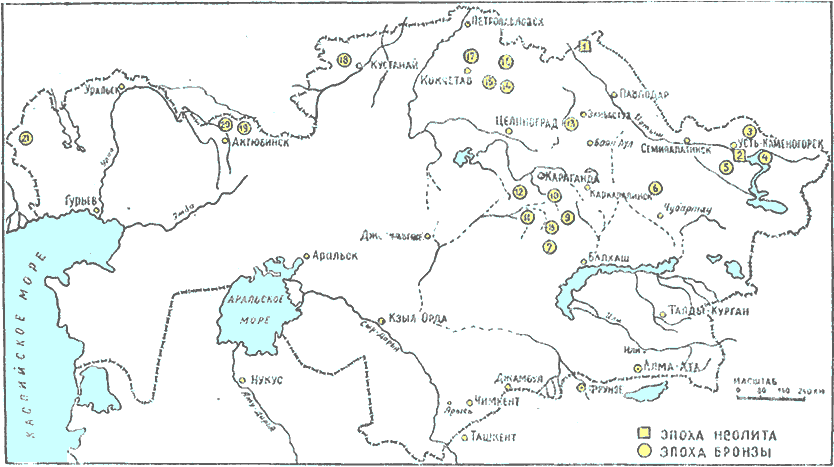
|
|||||||||||||||||||||||||
|
Before a general examination of the material we acquaint with what is at our disposal. These materials came from the Karaganda, Pavlodar, Semipalatinsk and East Kazakhstan provinces.
Within the limits of the first order race, the craniological type found in the burials is comparatively homogeneous . However, visually classifying individual skulls can attribute them to different versions of the Great Europoid race. Some of them have typical features of the Mediterranean type (female - Belasar [11] fencing 60, male - Nurmanbet [13] burials fencing 3, female - fencings 29 and 40). More often Mediterranean type is found among the entombed in the Nurmanbet [13] burials. and The Andronov type skulls also are observable (male - Kanattas [7] burials fencings 7 and 11, Karaozek [5] burials fencing 2). One skull has well expressed gracilization features of the Central Asian interfluve race (female - Chubartau [6] burials). Other skulls are difficult to differentiate by type. From the typological racial attributes of the examined skulls, the Kazakhstan population during Neolithic and Early Bronze Epoch period under examination consisted of different variations of the ancient Caucasoid racial trunk. In spite of the fact that the described skulls originated from different areas of Kazakhstan, they are synchronous and belong to the same Andronov culture. That allowed us compile a table of average dimensions, to receive a general idea about a physical type of the people that lived in these places. Because of a small number of female skulls, the average dimensions are calculated only using male skulls. For the male skulls are typical mezocrania (78,9), above average longitudinal (184,5) 1, cross (145,0) and hight (136,5) diameters of the cranium, the forehead in width stands at the upper range of medium dimensions (98,2), lightly sloped (87,2) with moderately expressed nose bridge, and considerably developed superciliary arches, a moderately projecting rounded shape nape.
The face is of medium height (71,2), but wide (138,6), orthognathous (88,0), moderately profiled in a horizontal plane, with moderately projected malar bones and moderately deep fang indentations. A nose of moderate height (54,7) and width (24,7), sharply projecting (34,3) with extremely large dacrial (13,9) and symotic (6,1) height dimensions. Orbits are low (32,2), medium wide and small indexes. By the major, high taxonomic attributes, that series belongs to Europoid race. The combination of a low and wide face skeleton with a strongly projecting nose with a weakly inclined forehead, and also with the low orbits is typical for the Andronov type. As a whole, the examined skulls are closest to the synchronous skulls from the northern, central and eastern areas of Kazakhstan described by V.V.Ginzburg (1956 a, 1956, 1962). To compare the physical type of the Kazakhstan Bronze Epoch population with the synchronous population of the adjacent areas we collected all the skulls of that epoch in a combined series. In it were included the paleoanthropological materials of M.N.Komarova (1927), G.F.Debets (1948), M.M.Gerasimov (1955), V.V.Ginzburg (1956 a, 1956, 1962), and of the author. As a result came out fairly large, for the Kazakhstan territory, series of skulls (15 male and 24 female) with typical features of Andronov variation of the proto-European race. To define the place of the series of the Kazakhstan Andronov Culture skulls among the other skulls of an Eneolith and Bronze Epoch, was compiled the Table 2. It assembled the paleoanthropological materials of Central Asia (Trofimova, 1961; Ginzburg, 1961), Southern Siberia (Alexeev, 1961), Altai (Alexeev, 1961) and the Lower Volga region (Debets, 1948; Ginzburg, 1959; Chtetsova, 1960; Firshtein, 1961). It should be noted that the average dimensions in the Table 2 of the Dalverzin series of skulls are received from the averages of female skulls, which for the lack of male skulls in that series are recalculated by the G.F.Debets (1961) method, i.e. the female dimensions are converted to the male dimensions. Comparing
the materials, it is easy to note that the examined
series of skulls from the Bronze Epoch differs sharply from the skulls
from the Kara - tepe and Geoksyur in the structure of a cranium and
the face skeleton. The series of skulls from the Painted Ceramics
culture is clearly characterized by expressed dolichocrania, mezognathic narrow face,
strongly profiled in the horizontal plane. The skulls of the
Kazakhstan Andronov Culture have considerably higher cranial index, orthognathous
relatively low and wide face, relatively greater nazo-malar and
zigo-maxilar angles. That and other markers tell about different
race genesis roots of the compared groups. |
|||||||||||||||||||||||||
18 start An analogous picture is also observed in comparing with series of skulls from Dalverzin. It is quite understandible, because the skulls from Dalverzin, like the skulls from Kara-tepe and Geoksyur, belong to the Mediterranean type (Ginzburg, 1962 à). Comparison of the ancient Kazakhstan skulls with Afanasiev skulls from Minusinsk depression shows that the skulls investigated by us have much higher cranium, somewhat larger cranial index, smaller face, more upright forehead and smaller nose projection. The most essential difference is in the height of the cranium and inclination of the forehead. By other attributes the difference between groups is insignificant. Our series also finds some morphological similarity with the skulls of the Afanasiev Cultures in Altai, differing from them by somewhat narrower and lower face, and also by a smaller projection angle of the nasal bones. Generally, the ancient Kazakhstan skulls are related to the skulls Afanasiev Cultures of Altai, but ours (Kazakhstan) groups the face is somewhat narrower and lower, and smaller projection angle of the nasal bones. As a whole, the ancient Kazakhstan skulls are closer to the Altai Afanasiev culture skulls than from the Minusinsk depression. No other craniological series from the compared groups find such anthropological similarity with the examined skulls, as the Andronov Culture skulls from Minusinsk depression. They so are close morphologically with each other that their similarity reaches a full identity. A similar picture is also observed in the archeological material. The commonality of culture and physical type undoubtedly testifies to the unity of their race genesis base. The extreme
affinity of material culture and morphological constitution of the Andronovans
from the Kazakhstan and Minusinsk depression brought
attention of researchers to the question about their initial areal. Was
the Andronov community formed in the Kazakhstan territory, and then
spread to the Minusinsk depression, or the other way around is not clear till now. On this
question a majority of anthropologists share the point of view of G.F.Debets,
which he formulated thirty something years ago (1940es),
according to which the Andronov variation of the proto-European race was formed in
the Kazakhstan steppes, and in the territory of Minusinsk depression it is a type of western
origin (Debets, 1948). To such He come tyo this conclusion on the
basis of studying the skulls of Afanasiev and Andronov Cultures of
the Minusinsk depression. A craniological analysis has shown that these groups are not genetically continuous, that was expressed mainly in the structure of the face skeleton, and partly in the relief of the skull. So, the face of the later skulls of the Andronov culture is lower and wider, and the relief of a skull is stronger, than among the earlier skulls of the Afanasiev Cultures. Hence, in the same territory the distinctions between two series of skulls developed in opposite directions, whereas in a case of anthropological continuity should be expected a different process, for during the epochal evolution the face becomes narrower, the relief of the skull decreases, and as a whole the skull grows to a more gracial aspect. However on Andronov Culture skulls that was not found. Therefore it is quite possible that Andronovans were not direct descendants of the Minusinsk depression Afanasievans (Debets, 1948). Probably, the Kazakhstan spacious open steppe was that area where really went the formation process of the Andronov variation of the proto-European race. The archeological data also confirm that theory though some archeologists also expressed other views on the origin of the Andronovans, which we reviewed above. Juxtaposing the ancient Kazakhstanians with the synchronous population of the Lower Volga steppe belt turned out that in the type they are related to the tribes of the Timber-Grave Culture. By a number of attributes the ancient Kazakhstanians approach the tribes of the earlier, Pit-Grave Culture. From the skulls of the Pit-Grave Culture the skulls of Timber-Grave Culture differ by a sharply expressed mezocrania, relatively low and narrow face, significantly more upright forehead, less projecting nose. Against the skulls of Timber-Grave Culture the examined Kazakhstan series is characterized by higher cranial index, somewhat more upright forehead, and less projecting nose. In the other attributes their common morphological similarity is totally obvious. Such similarity of anthropological type of the population of Kazakhstan to the population of the Lower Volga region during the Bronze Epoch indicates their genetic commonality. Their genetic commonality is also confirmed archeologically. In respect to the skulls of the Catacomb Culture, typically they have somewhat more profiled face at the level of zigo-maxyllar point, higher dacrial index, very strongly projecting nose compared with Andronov Culture skulls of Kazakhstan. The Catacomb Culture skulls are less similar to the ancient Kazakhstanians than with the tribes of Timber-Grave and Pit-Grave Cultures. Finally, the median dimensions of Andronov Culture skulls were compared
with the median dimensions of the skulls from the Kokcha 3 burial,
belonging to the Tazabagyab Culture. Against the Tazabagyab Culture,
the skulls of the examined Kazakhstan series have the cranium somewhat lower,
forehead inclination much lower, face much wider, orthognathic, nasal index much higher, and orbits somewhat higher. The most common attributes between them are the linear dimensions of the cranium, upper height of the face, degree of profiling in a horizontal plane, and the height of the nose bridge. In main morphological attributes the skulls of the Andronov Culture find a close similarity to the skulls of the Tazabagyab Culture, which probably attests to the commonality of their origin. Among some skulls from Kokcha 3 T.A.Trofimova noted few peculiar features that are not typical for the Bronze Epoch population of the steppe belt. In her opinion, these features are connected with Indo-Dravidian racial type (Trofimova, 1961). Such admixture in anthropological type of the population of Southern Akchadarya delta testifies not only to a complex ethnogenetical processes of the Central Asian peoples, but also uncover the deep roots of their ethnic connections with the ancient East. Despite of that, as a whole the skulls of the Bronze Age Kazakhstan are most close to the skulls of the Tazabagyab culture. Before discussing the comparative results of the groups by median dimensions, turn to the general flatness indexes of the face skeleton, as an important parameter in the high value taxonamical attribute racial scheme. The median index for flatness of the face is calculated by G.F.Debets method (1961, 1968). By the degrees of the face skeleton flatness, the compared groups are sorted in this order:
By the general parameter of the flatness of the face skeleton, the examined Kazakhstan series is very close to skulls from Kokcha 3 and Andronov Culture of Minusinsk depression. Most considerably it differs from the skulls Catacomb Culture. That difference is so great that it falls outside the limits of three sigmas,
which did not happen in the comparison by median dimensions. By this index for the flatness of the face skeleton
the skulls of the Catacomb Culture strongly contrast even with the skulls
of the Pit-Grave and Timber-Grave Cultures, despite the commonness of
their territory. In that connection seems to be more probable the G.F.Debets hypothesis (1948) about
propagation in the Northern Pontic steppes of the Catacomb Culture as a result of
outside migration. Irrespective of the resolution of that question, to attention come the essential distinctions in the structure of the face skeleton between the populations of the Catacomb and Andronov cultures. Thus, the comparison of the racial types of Kazakhstan and adjacent areas does not leave any doubts that the population of the Kazakhstan Bronze Epoch territory had strongly pronounced features of the Great Europoid race. Genetically, it had much in common with the populations of Southern Siberia and Aral area. Should also be noted some anthropological affinity between the ancient Kazakhstan tribes and the tribes of Timber-Grave and Pit-Grave Cultures of the Lower Volga region. Judging by our materials, the Andronov component of the proto-European race was significant among the local residents of Kazakhstan. Therefore during a long period of the Kazakhstan ethnic history it was a major substrate in the race genesis process of the local tribes. At the same time should be stated that the close examination of all skulls of the Kazakhstan Neolithic and early Bronze Epoch found anthropological heterogeneity among the ancient Kazakhstanians. Can't be excluded a prospect that accumulation of paleoanthropological material would find other variations of the proto-European races in their composition.
|
|||||||||||||||||||||||||
